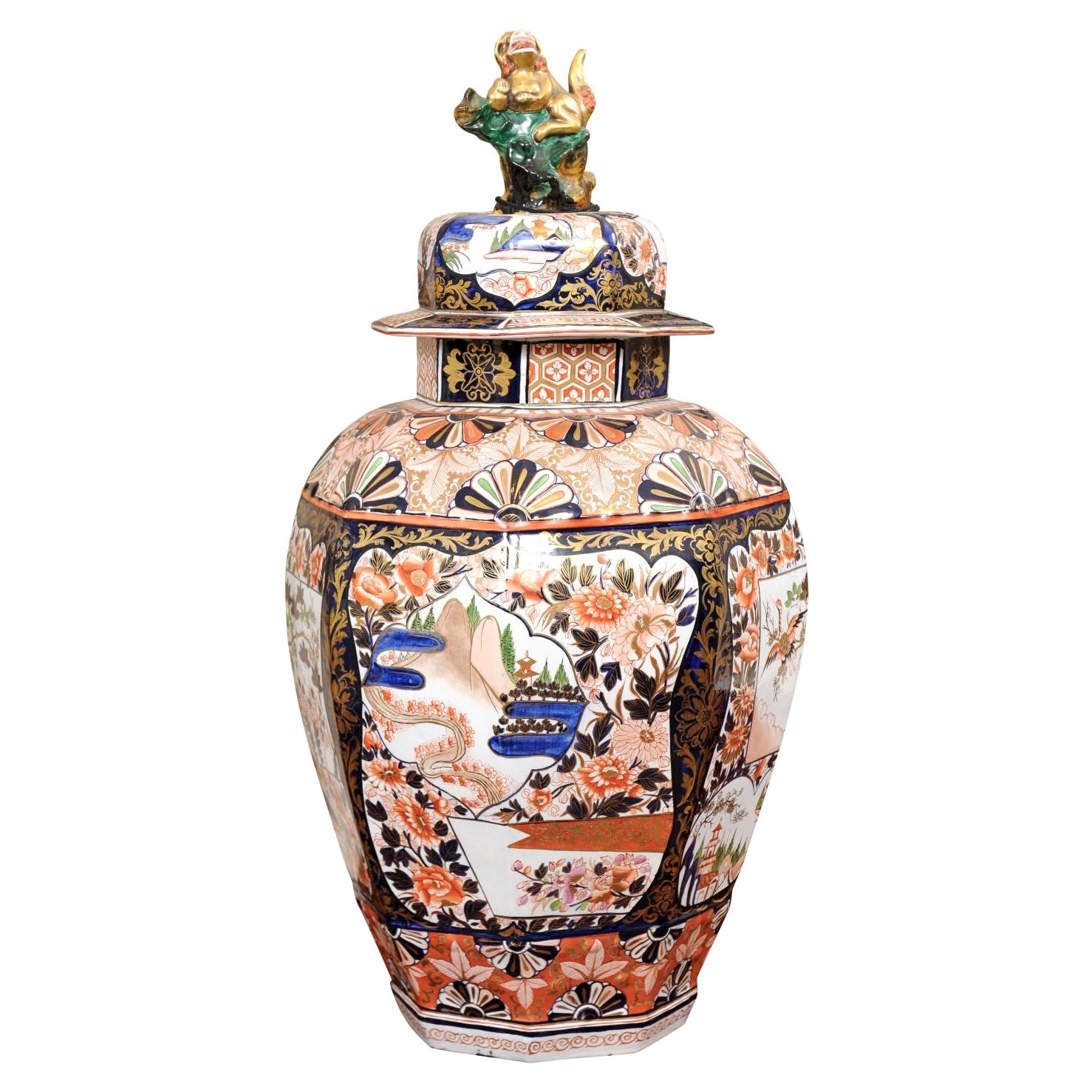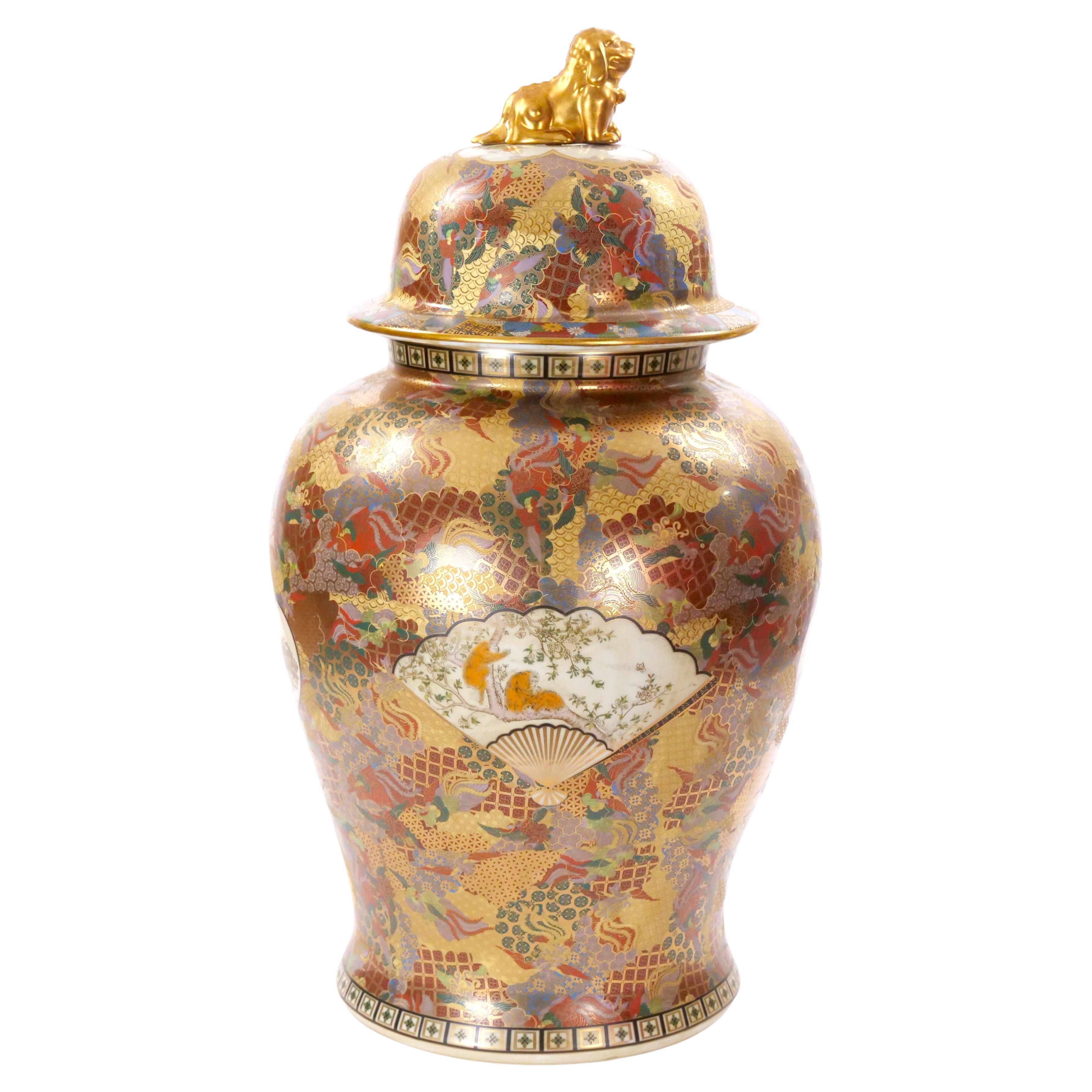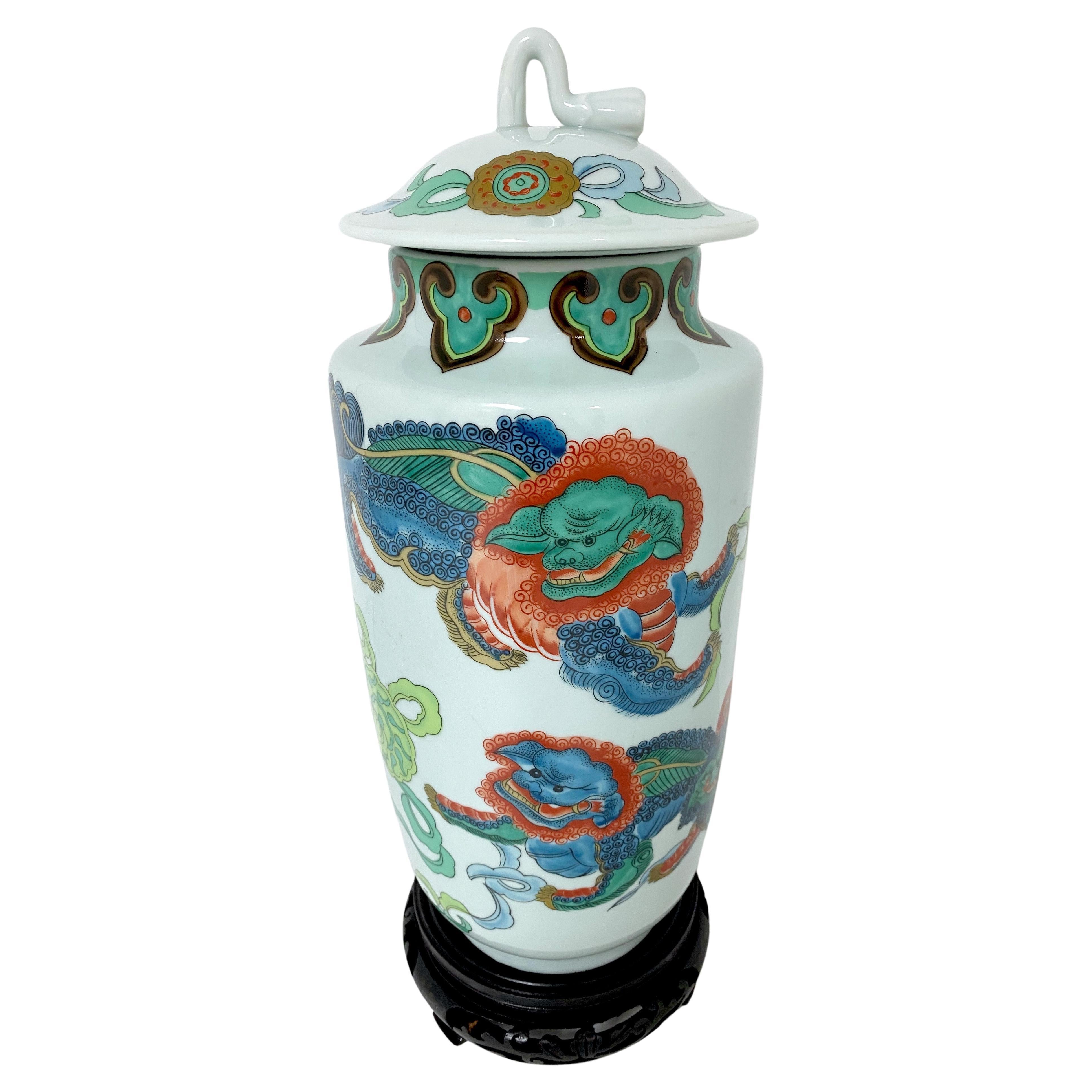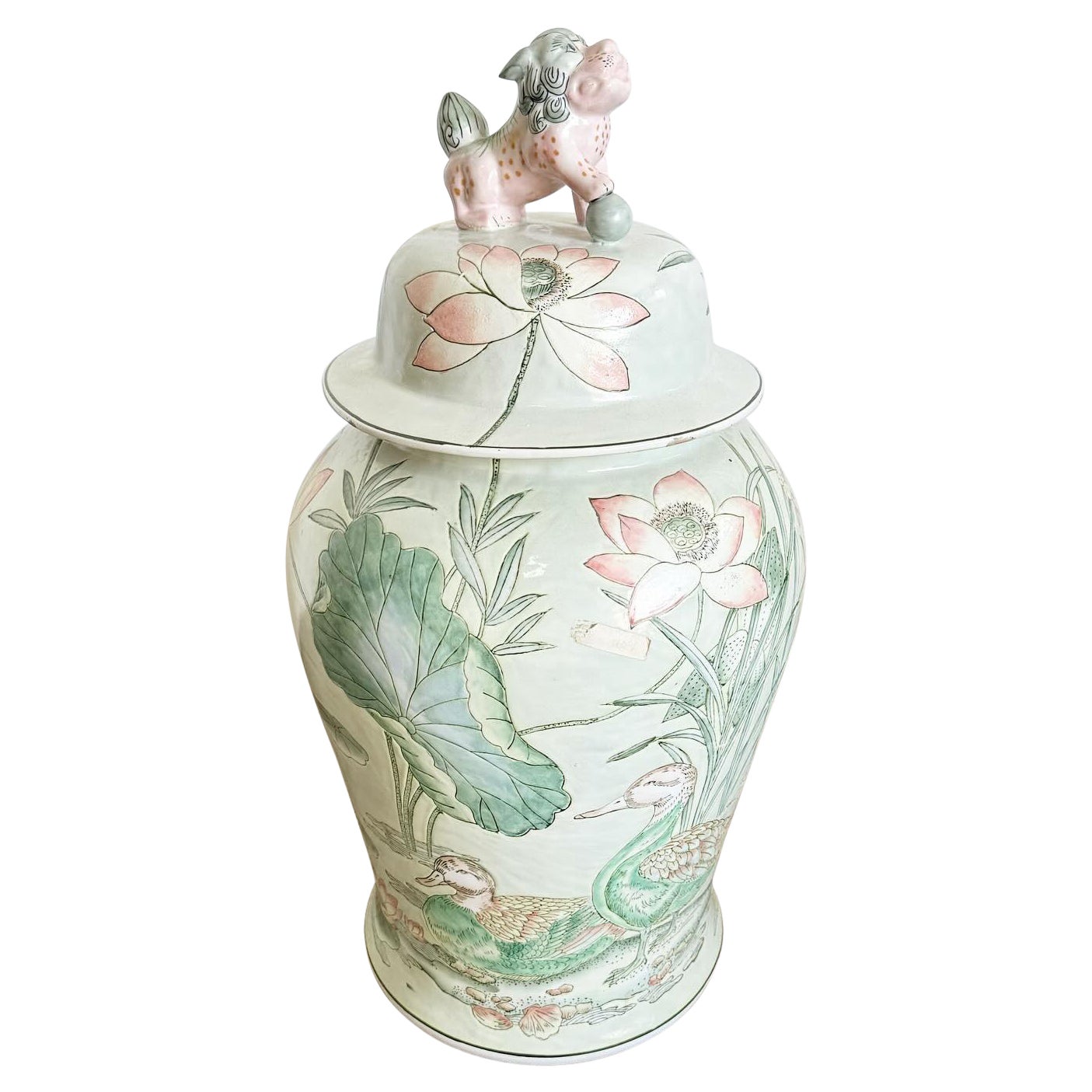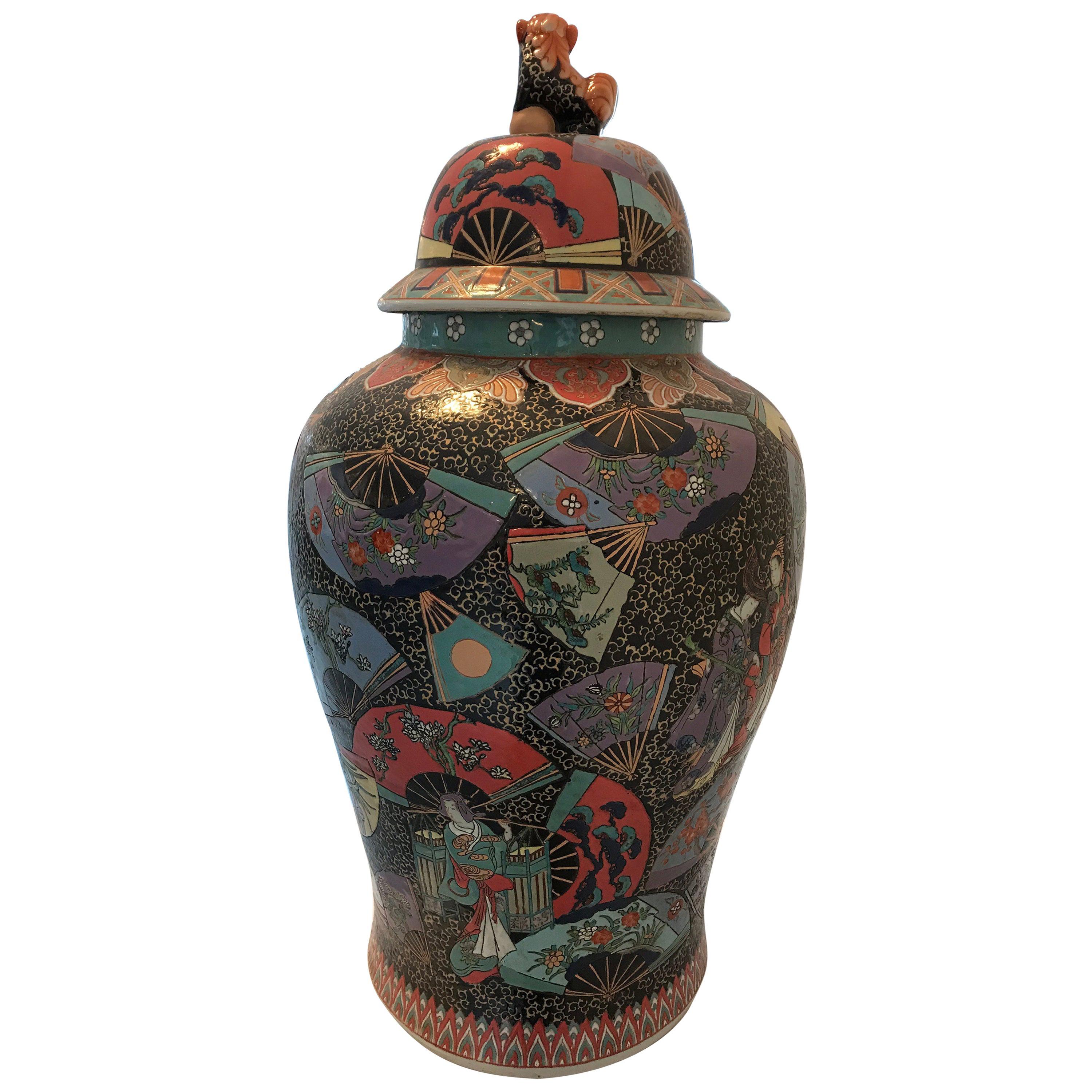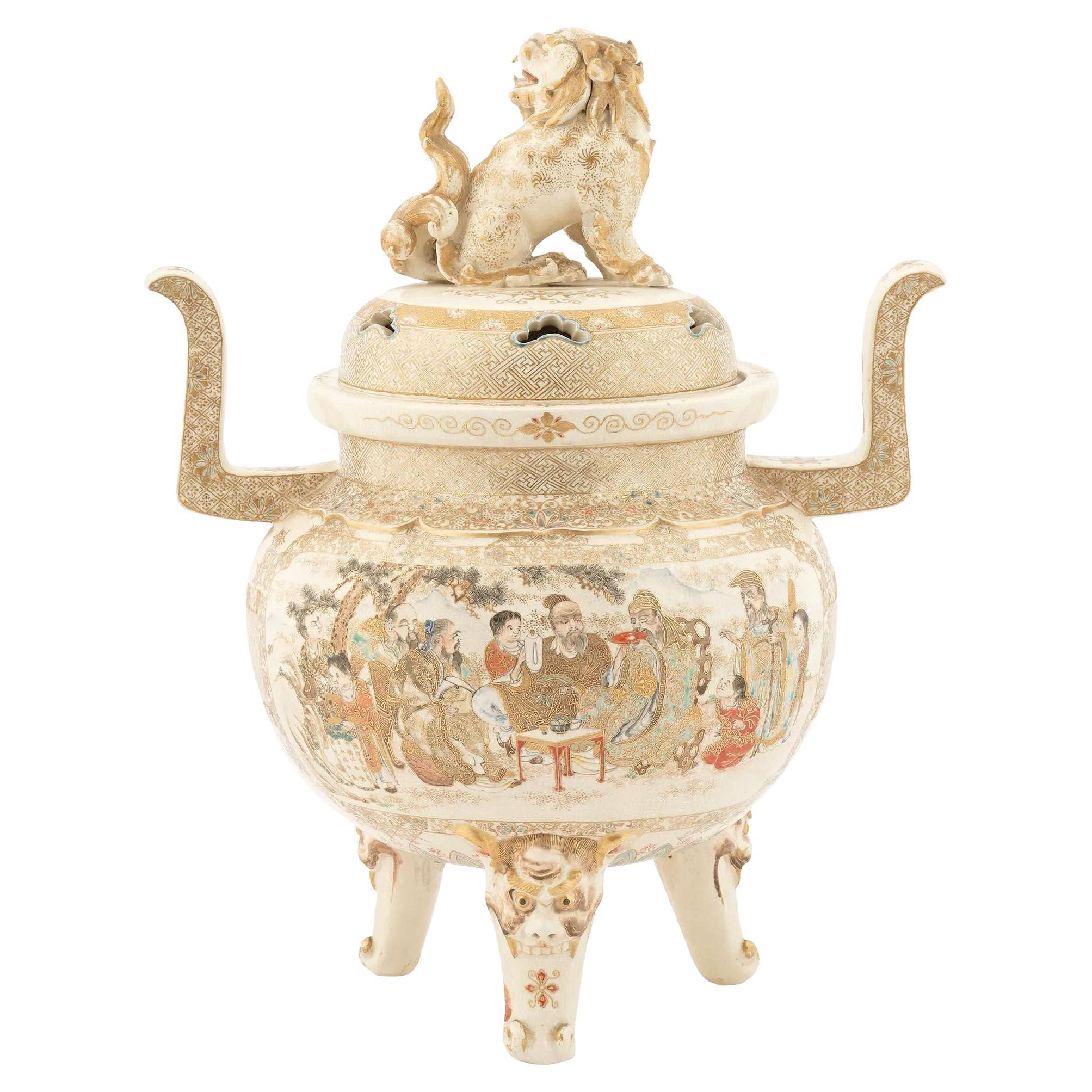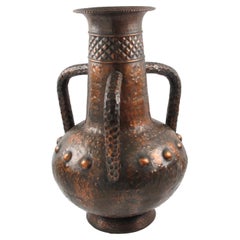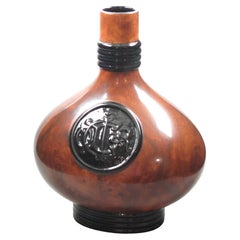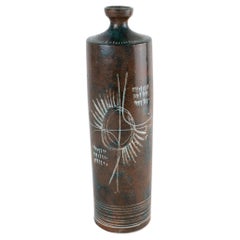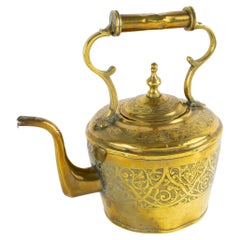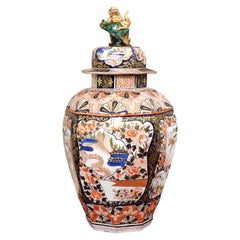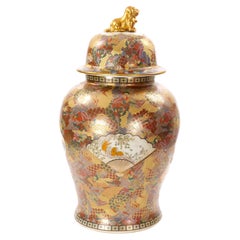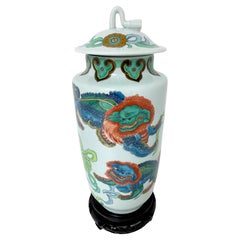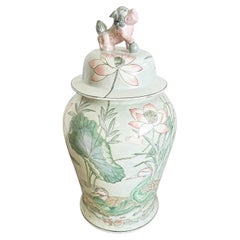Items Similar to Meiji Satsuma Earthenware Urn or Vase with Foo Dog Sculpture, circa 1880
Want more images or videos?
Request additional images or videos from the seller
1 of 21
Meiji Satsuma Earthenware Urn or Vase with Foo Dog Sculpture, circa 1880
$7,500
£5,694.93
€6,512.58
CA$10,478.59
A$11,654.48
CHF 6,085.61
MX$141,822.59
NOK 77,722.47
SEK 72,889.97
DKK 48,605.84
Shipping
Retrieving quote...The 1stDibs Promise:
Authenticity Guarantee,
Money-Back Guarantee,
24-Hour Cancellation
About the Item
A magnificent testament to the artistry of the Japanese Meiji period (1868-1912), this rare Satsuma earthenware urn is an extraordinary find. Crafted in Japan circa 1880, its delicate crackled glaze enhances its timeless allure, while its opulent decoration captivates the eye. Rich polychrome enamels bring the Lohan scenes to life, elegantly highlighted with luminous gilt accents. The urn's gracefully upturned handles and intricately sculpted lid, crowned with a striking Foo dog or dragon figure, amplify its regal presence. Raised on three sculptural legs adorned with animal heads that seamlessly merge into paw feet, this masterpiece exudes both strength and refinement. A faded artist's signature graces the interior edge of the lid—a subtle yet significant mark of its authenticity. This exceptional creation is a true jewel of Japanese artistry, destined to command admiration. This is an exceptional and rare Satsuma earthenware urn or covered vase from the Japanese Meiji period (1868-1912). It has upturned handles and a gorgeous lid with a Foo dog or dragon carved sculpture. A faded artist's signature is on the interior edge of the lid.
Dimensions: 12.63 in wide (32 cm) by 8.69 in deep (22 cm) by 18.50 in high (47 cm).
Note: Mahayana Buddhism regarded a group of eighteen Arhats (with different names and personalities) as awaiting the return of the Buddha as Maitreya. Other groupings of six, eight, sixteen, one hundred, and five hundred characters appear in tradition and Buddhist art, especially in East Asia, and are referred to as luohan or lohan. One can see them as the Buddhist equivalents of the Christian Saints, apostles, or early disciples and leaders of the faith.
(Credit: Wikipedia).
- Creator:Satsuma (Maker)
- Dimensions:Height: 18.5 in (46.99 cm)Width: 12.63 in (32.09 cm)Depth: 8.69 in (22.08 cm)
- Style:Meiji (Of the Period)
- Materials and Techniques:
- Place of Origin:
- Period:
- Date of Manufacture:Late 19th Century
- Condition:The vase is in good condition, with a tiny hairline on the inner side of the lid. The airline is not crossing through, and it does not significantly affect the overall appearance since it is not visible from the outside. Check the two close-ups.
- Seller Location:Atlanta, GA
- Reference Number:Seller: 5T149CFABAF1stDibs: LU1632243025032
About the Seller
5.0
Platinum Seller
Premium sellers with a 4.7+ rating and 24-hour response times
Established in 1995
1stDibs seller since 2015
1,075 sales on 1stDibs
Typical response time: <1 hour
- ShippingRetrieving quote...Shipping from: Atlanta, GA
- Return Policy
Authenticity Guarantee
In the unlikely event there’s an issue with an item’s authenticity, contact us within 1 year for a full refund. DetailsMoney-Back Guarantee
If your item is not as described, is damaged in transit, or does not arrive, contact us within 7 days for a full refund. Details24-Hour Cancellation
You have a 24-hour grace period in which to reconsider your purchase, with no questions asked.Vetted Professional Sellers
Our world-class sellers must adhere to strict standards for service and quality, maintaining the integrity of our listings.Price-Match Guarantee
If you find that a seller listed the same item for a lower price elsewhere, we’ll match it.Trusted Global Delivery
Our best-in-class carrier network provides specialized shipping options worldwide, including custom delivery.More From This Seller
View AllMonumental Italian Copper Baluster Urn Amphora Vase
By Midcentury Italian school
Located in Atlanta, GA
This monumental handmade baluster form urn vase with handles was hand-crafted in Italy circa 1960. The hand-worked details on the copper, along with its beautiful patina, give this v...
Category
Mid-20th Century Italian Baroque Revival Vases
Materials
Metal, Copper
Christian Dior Ceramic Vase with Faux Wood Decor, circa 1980
By Dior Home, Christian Dior
Located in Atlanta, GA
This stunning Christian Dior Paris amphora-shaped ceramic vase is a beautiful accent piece for any private interior. The rare piece was crafted in France circa 1980 for the Dior Inte...
Category
Vintage 1980s French Modern Vases
Materials
Ceramic, Faience
Yvon Roy for Atelier Montgolfier Glazed Terracotta Ceramic Vase, circa 1950
By Montgolfier, Yvon Roy
Located in Atlanta, GA
This outstanding, bottle-shaped ceramic vase, crafted circa 1950, was designed by the renowned French ceramist Yvon Roy for Ateliers d'Art Montgolfier in Durtal, Anjou, France.
Made ...
Category
Vintage 1950s French Mid-Century Modern Vases
Materials
Ceramic, Earthenware, Faience
Antique Moroccan Repoussé and Carved Brass Tea Kettle, circa 1880
By Various Makers
Located in Atlanta, GA
This antique brass tea kettle, meticulously handcrafted in the late 19th century, is a remarkable example of traditional Islamic metal artistry. Originating from Morocco, the piece s...
Category
Antique Late 19th Century Moroccan Islamic Serving Pieces
Materials
Brass, Copper
Luigi Carron for Alcyone Mid-Century Ceramic Vase, Italy 1950s
By Carron
Located in Atlanta, GA
Luigi Carron designed this stunning Mid-Century Modern ceramic vase for Alcyone of Marostica, Italy, circa 1950. The chunky amphora shape has painted geometric and stylized animal de...
Category
Vintage 1950s Italian Modern Vases
Materials
Ceramic, Faience
Empoli Italy Sculptural Art-Glass Pitcher, Decanter
By Empoli
Located in Atlanta, GA
This stunning Empoli, Italy, hand-blown art glass pitcher or decanter is a gorgeous piece of Italian craftsmanship. This tall pitcher features an Etruscan shape with a hobnail patter...
Category
Vintage 1950s Italian Mid-Century Modern Glass
Materials
Blown Glass
You May Also Like
Ironstone Urn & Lid with Foo Dog Finial, England ca. 1820
Located in Atlanta, GA
Ironstone Urn & Lid with Foo Dog Finial, England ca. 1820.
Category
Antique Early 19th Century English Urns
Materials
Ironstone
Large Hand Decorated Meiji Satsuma Covered Urn with Foo Dog
Located in Tarry Town, NY
Step into the exquisite world of Meiji period artistry with this magnificent Satsuma porcelain covered urn, a true masterpiece of Japanes...
Category
Early 20th Century Asian Centerpieces
Materials
Porcelain
Japanese Arita Foo dog Motif Covered Urn, with Carved Hardwood Stand
Located in West Palm Beach, FL
Japanese Arita Foo dog Motif Covered Urn, with Carved Hardwood Stand
Japan, 20th Century
A fine Japanese Arita Foo Dog Motif Covered Urn, accompanied by a carved hardwood stand, m...
Category
20th Century Japanese Ceramics
Materials
Porcelain, Hardwood
$716 Sale Price
20% Off
Chinese Large Ginger Jar/Vase With Foo Dog Lid
Located in Delray Beach, FL
The Chinese Large Ginger Jar/Vase with Foo Dog Lid is a remarkable display of Chinese artistry. Featuring a sculpted foo dog on the lid, it symbolizes protection and adds asian charm...
Category
20th Century Chinese Chinoiserie Scholar's Objects
Materials
Ceramic
Chinese Ginger Jar with Foo Dog Topper
Located in Dallas, TX
This large 1950s Chinese ginger jar is made of many bright, contrasting and vibrant colors. The cover of the jar has a foo dog on top of it adding some authentic Chinese decoration.
Category
Vintage 1950s Chinese Jars
Materials
Porcelain
Japanese Meiji Period Satsuma Tripod Censer
Located in New York, NY
Very fine quality Japanese Meiji period Satsuma tripod censer with a foo dog finial.
wonderful painting quality.
Category
Antique Late 19th Century Japanese Meiji Ceramics
Materials
Ceramic
More Ways To Browse
Single Foo Dog Jade Or Marble
Japanese Earthenware
Japanese Dog
Meiji Figure
Rare Antique Asian Vases
Carved Dog Head
19th Century Satsuma Vases
19th Century Japanese Satsuma Vases
Antique 19th Century Japanese Satsuma Vase Vases
Antique Japanese Urns
Meiji Dragon Vase
Foo Dog Vases
Polychrome Urn
Crown Buddha
Crowned Buddha
Vase With Foo Dog
Dragon Urn
19th Century Vases With Dragon Handles
